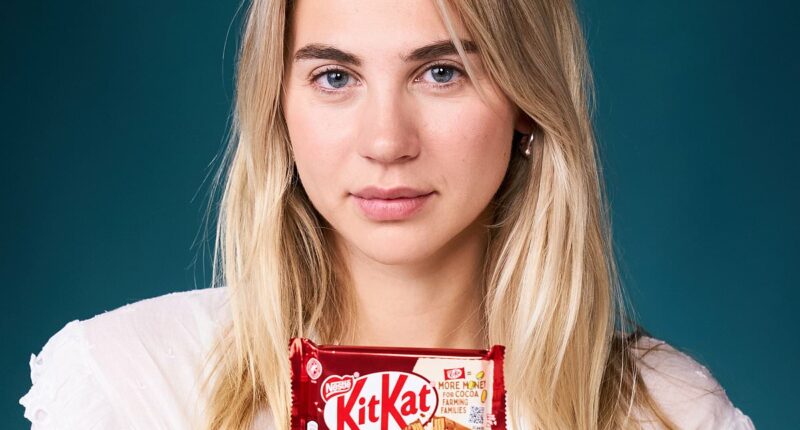Share this @internewscast.com
Let’s be honest, the humble KitKat has never been the trendsetter of the chocolate world. It’s long been the reliable option: pleasant, well-known, and perhaps a tad dull.
For a good reason, actually. KitKats were created as a convenient snack, stemming from an employee’s suggestion to Rowntree’s in the 1930s to develop a chocolate bar suitable for taking to work.
Since then, the two-or four-finger snack – along with the beloved KitKat Chunky, launched in 1999 – has become a fixture in train station vending machines, office lunchrooms, and your mother’s secret snack stash.
They weren’t considered fashionable – that is, until recently. In the past few years, KitKats have experienced what we young folks call a ‘glow-up’, with numerous new flavors hitting the market.
And a recent survey of seven to 14-year-olds by consultants Beano Brain corroborated this, ranking KitKat as the tenth ‘coolest’ brand among this age group.
It all started in Japan, where KitKat sounds a lot like kitto katsu, which means ‘you will surely win’.
This neat little coincidence turned the bar into a good luck charm for students before exams, and it wasn’t long before Nestle, who acquired Rowntree’s in 1988, recognized an opportunity and capitalized on it.
As a result, since the early 2000s Japan has unleashed more than 300 different flavours, featuring everything from matcha green tea to sweet potato, melon, and even wasabi.

Mimi Yates tries out a range of Japanese KitKats – but which one is the yummiest?

Since the early 2000s Japan has unleashed more than 300 different flavours, featuring everything from matcha green tea to sweet potato, melon, and even wasabi
Unsurprisingly, the trend has been supercharged by social media. Platforms such as TikTok and Instagram are flooded with taste-test videos of exotic KitKats sourced from Japanese import stores or online retailers.
It doesn’t hurt that the modern packaging – miniature bars, often in pastel colours with delicate Japanese script – is visually pleasing, although it’s not just about aesthetics: young people are far more adventurous when it comes to food, and constantly on the hunt for experiences that feel a bit niche.
The rise of K-pop, anime and Japanese and Korean skincare has also contributed to a wider appreciation of East Asian culture.
This shift hasn’t gone unnoticed. Shops in the UK and US are reporting increasing demand for Japanese snacks, and Nestle has started releasing some of their cult flavours worldwide – albeit in maddeningly limited batches (good luck trying to get your hands on wasabi or apple, ‘rare’ flavours fans hunt like exotic truffles).
The big question, of course, is whether these flavours are any good. Being the brave 25-year-old snack researcher that I am, I tried some for my own taste-test video.
The verdict? Some are weirdly amazing (hello, matcha latte), while others should have been left on the production line.

Platforms such as TikTok and Instagram are flooded with taste-test videos of exotic KitKats sourced from Japanese import stores or online retailers

Shops in the UK and US are reporting increasing demand for Japanese snacks, and Nestle has started releasing some of their cult flavours worldwide
Mint choc chip
Given this is a flavour I’ve only ever encountered in ice cream, I wasn’t surprised to find that this was what it tasted like – with a touch of After Eight thrown in.
It was definitely minty and if I closed my eyes and ignored the slightly speckled green colouring on top of the bar, I might have thought I was biting into a creamier version of a mint Aero. The army of fans of KitKat’s dark mint variety, which was discontinued a year ago, would find this a good consolation prize.
Strawberry
This certainly looks pretty – it’s white chocolate with pinky bits to mimic a strawberry, and it tastes like one too.
But, overall, I found it a bit too sickly.
This is for those who really like chocolate on the sweet side, and it wasn’t for me.
Milk tea
Yum! This was a win. It was also on the sweet side, but tempered by what tasted like a flick of Earl Grey and biscuits.
Probably the closest you’ll get to bubble tea (for the uninitiated, a Taiwanese beverage typically containing a base of tea, milk or fruit, and chewy tapioca pearls known as boba) in chocolate bar form.
Matcha latte
Double yum! This was my absolute favourite, probably because it tastes like the drink I buy religiously every morning on the way to work.
Matcha, a finely ground powder made from specially grown and processed green tea leaves, has become a craze in the UK – mainly because it gives you an energy boost without the jitters of coffee. I don’t think I felt any different after munching on this, but I definitely enjoyed it.
Dark chocolate
This is likely the most traditional option from the array of alternatives on offer, and it seems to be the more sophisticated choice when set against the others.
If you generally like dark chocolate, then this is the one for you.
Chocolate orange
While this tasted very similar to a Terry’s Chocolate Orange, it was not quite as nice.
It had a slightly bitter aftertaste which you don’t get from a Terry’s, who needn’t be worried about this version snapping at their heels. I wasn’t a fan.
Strawberry shortcake
This was like a Chupa Chups lollipop in chocolate form, which is either a good thing or a bad thing depending on your tastebuds.
Like the strawberry, it has white chocolate laced through with bits of pink, is very sweet and reminded me of the sort of slightly sickly cake a friend’s grandma used to make.
Strawberry gateau chocolate
Have you ever bitten into chocolate that feels like it has been sitting around for too long?
If so, you’ll have a sense of what it would be like to chomp on this. It was cake-like, and quite rich, but I couldn’t shake the sense I was eating something that had outlived its shelf life.
Cookies and cream
I though I would love this as on the packaging it looked like a KitKat version of an Oreo biscuit. Then I bit into it and found it tasted too milky and left a bit of a claggy aftertaste.
KitKat gold
It wasn’t really clear from the packet what this was meant to be, but my tastebuds deciphered salted caramel in the mix. It tasted a bit saltier and less ‘chocolatey’, which I enjoyed – although maybe because at this point I’d had my fill of the sweet stuff.
Classic
You can’t taste KitKats without trying the original and best.
There’s a reason this has been a national favourite for decades. The perfect combination of milk chocolate and wafer, it still holds its own against fancier rivals.




